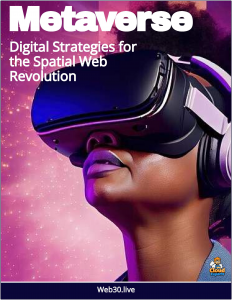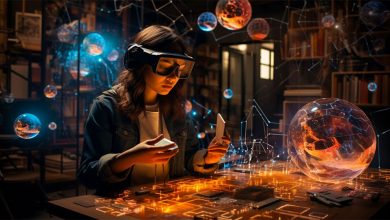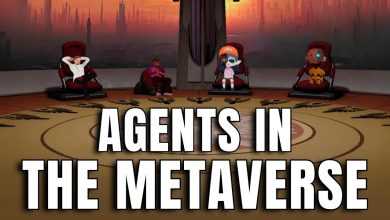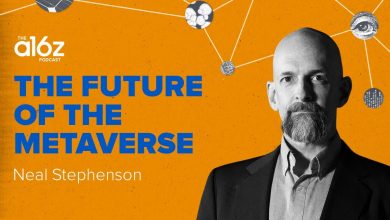The Lawnmower Man – VR Holds the Key to the Evolution of the Human Mind
1992's movie The Lawnmower Man envisioned a Metaverse that could massively evolve the human mind.
 Ironically today in the 2020’s the visions of the Metaverse we are presented with, by the likes of Facebook and Microsoft, are really quite dull.
Ironically today in the 2020’s the visions of the Metaverse we are presented with, by the likes of Facebook and Microsoft, are really quite dull.
The same boring office meetings, but in a virtual world -YAWN-
For a more fertile set of ideas we can travel back to the 90’s, when the Internet was in it’s infant years and thus the sense of potential and excitement was much more expansive and ambitious.
30 years ago (!) Hollywood gave us The Lawnmower Man, a movie that explored an idea of the Metaverse which, as Pierce Brosnan’s character describes, holds the potential to evolve the human mind far beyond it’s born limitations.
Unlocking the Full Human Capacity and Potential
This is achieved through entering a Virtual Reality world and engaging in various experiences that rewire how the brain and mind works, including even the development of telekinesis abilities.
Ok it concludes with the central character, a gardener with the mind of a child, evolving to such an extent he becomes a megalomaniacal psychopath, the important point is to stretch our ambition to imagine vastly more exciting potential for the Metaverse than Microsoft Office 2030.
It’s often been said that we only use a small % of the potential of what the human mind is fully capable of, and perhaps unlocking this complete capacity could be one major advance that the Metaverse makes possible.
The interplay between virtual reality (VR) and the metaverse could significantly influence the evolution of the human mind, not in a strictly biological sense (like genetic changes over generations), but rather through neuroplasticity, cognitive adaptation, and shifts in perception, behavior, and social frameworks.
Enhanced Neuroplasticity and Cognitive Flexibility
VR and metaverse experiences plunge users into fully immersive, interactive environments that demand rapid adaptation to new rules, physics, and sensory inputs. This could accelerate neuroplasticity—the brain’s ability to reorganize itself by forming new neural connections.
Regularly navigating virtual worlds with altered realities (e.g., zero-gravity spaces or multi-sensory simulations) might strengthen cognitive flexibility, enabling humans to think more abstractly and adapt to ambiguity faster than in physical-world contexts. Over time, minds accustomed to switching between diverse virtual frameworks could become more adept at problem-solving across domains, potentially elevating baseline creativity and resilience.
For example, a user mastering a VR game with non-Euclidean geometry might rewire spatial reasoning pathways, subtly shifting how they perceive and interact with physical space. Multiply this across millions in a metaverse, and you could see a population with heightened mental agility—a mind evolved to thrive in multiplicity.
Expanded Sense of Self and Empathy
The metaverse, as Stephenson envisions, emphasizes social interaction in customizable, avatar-driven spaces. Embodying different identities—whether a humanoid, an animal, or an abstract entity—could stretch the boundaries of self-concept. Research on VR’s “body transfer illusion” shows that inhabiting another’s perspective (e.g., a different gender or species) can boost empathy by rewiring mirror neuron activity.
In a metaverse where users routinely “live” as others, the human mind might evolve to hold a more fluid, less egocentric identity, weakening rigid us-versus-them divides.
This could lead to a collective mental shift toward greater emotional intelligence and interconnectedness. However, it might also blur the line between real and virtual selves, potentially causing dissociation or identity fragmentation if not balanced with grounding in physical reality.
Rewritten Memory and Perception
VR and the metaverse could transform how we encode and recall experiences. Immersive environments, rich with sensory detail, might create “false memories” indistinguishable from physical ones, as the hippocampus struggles to differentiate sources. A mind regularly exposed to such vivid simulations could evolve to prioritize experiential depth over factual accuracy, valuing narrative coherence over linear truth.
This aligns with Stephenson’s focus on compelling experiences—future humans might judge reality by its emotional resonance rather than its origin.
Perception itself could shift as VR recalibrates sensory processing. Extended time in environments where sight, sound, and even haptic feedback are artificially tuned might desensitize users to physical-world stimuli or heighten sensitivity to digital cues. The mind could evolve to “see” the world through a layered lens, instinctively merging virtual and physical inputs into a hybrid reality.
Accelerated Learning and Skill Acquisition
The metaverse’s potential as a training ground—think flight simulators on steroids—could turbocharge how humans acquire knowledge. VR’s ability to simulate complex scenarios (e.g., performing surgery or debating in a foreign language) engages procedural memory and muscle memory faster than traditional methods.
A mind evolved in this context might develop a bias toward experiential learning, with neural circuits optimized for rapid skill uptake and real-time feedback loops. Over generations, this could produce humans who intuitively excel at mastering new domains, shrinking the gap between novice and expert.
Stephenson’s gaming-centric metaverse amplifies this: economies built on play could turn learning into an instinctive, gamified process, rewiring reward systems to crave mastery over passive consumption.
Social Evolution and Collective Consciousness
A decentralized, interoperable metaverse could forge a hive-like social mind, where shared virtual experiences create a quasi-collective consciousness. If millions collaborate in real-time across borders, solving problems or co-creating worlds, the human mind might evolve to prioritize group cognition over individual isolation.
Mirror neurons and social reward circuits could strengthen, making cooperation and communal identity second nature. Stephenson’s open metaverse hints at this—free from corporate silos, it could foster a mental evolution toward unity, though it risks amplifying groupthink if unchecked.
Conversely, over-reliance on virtual interaction might atrophy face-to-face social skills, evolving minds that excel digitally but falter physically, creating a bifurcated social capacity.
Potential Risks: Dependency and Reality Drift
The mind’s evolution could take darker turns. Constant VR immersion might rewire dopamine pathways, making virtual rewards more compelling than physical ones, leading to a dependency akin to addiction. A mind evolved in this state might struggle to find meaning outside the metaverse, shrinking its capacity for unmediated joy.
Similarly, prolonged detachment from physical consequences (e.g., pain or scarcity) could dull risk assessment and survival instincts, producing a psyche overly trusting of curated environments. Stephenson’s caution about corporate control adds another layer: a mind shaped by a monopolized metaverse might evolve into a passive consumer, its critical faculties dulled by algorithmic manipulation.
Long-Term Speculation
Over decades or centuries, these shifts could compound. A metaverse-evolved mind might boast a kaleidoscopic imagination, empathic breadth, and a native fluency in digital-physical hybridity—qualities Stephenson’s vision implicitly nurtures. Yet it might also grapple with existential disorientation, tethered to virtual anchors over physical ones. Biologically, evolution would lag, but culturally and neurologically, the human mind could become a dynamic, adaptive entity, molded by the tools it wields.
In short, VR and the metaverse might evolve the mind into a more versatile, connected, and experiential organ—capable of extraordinary leaps, yet vulnerable to losing its roots in the tangible world. It’s a trade-off Stephenson might see as inevitable: a mind expanded by its creations, for better or worse.



